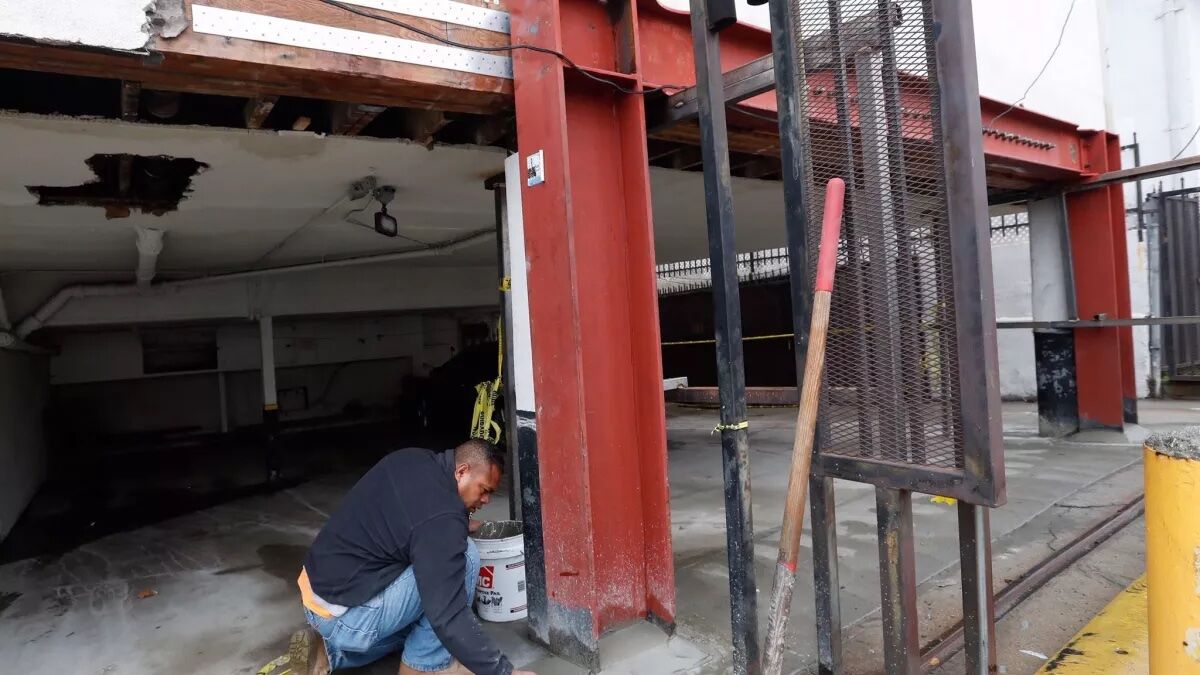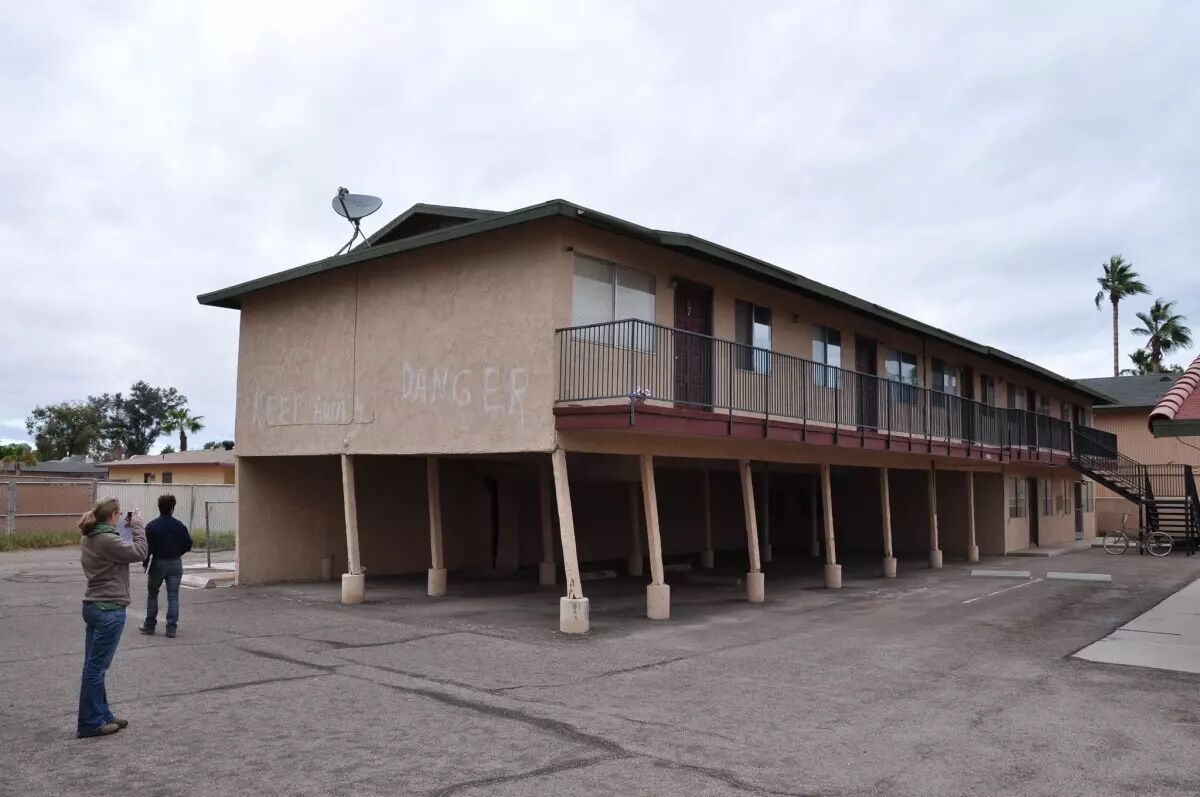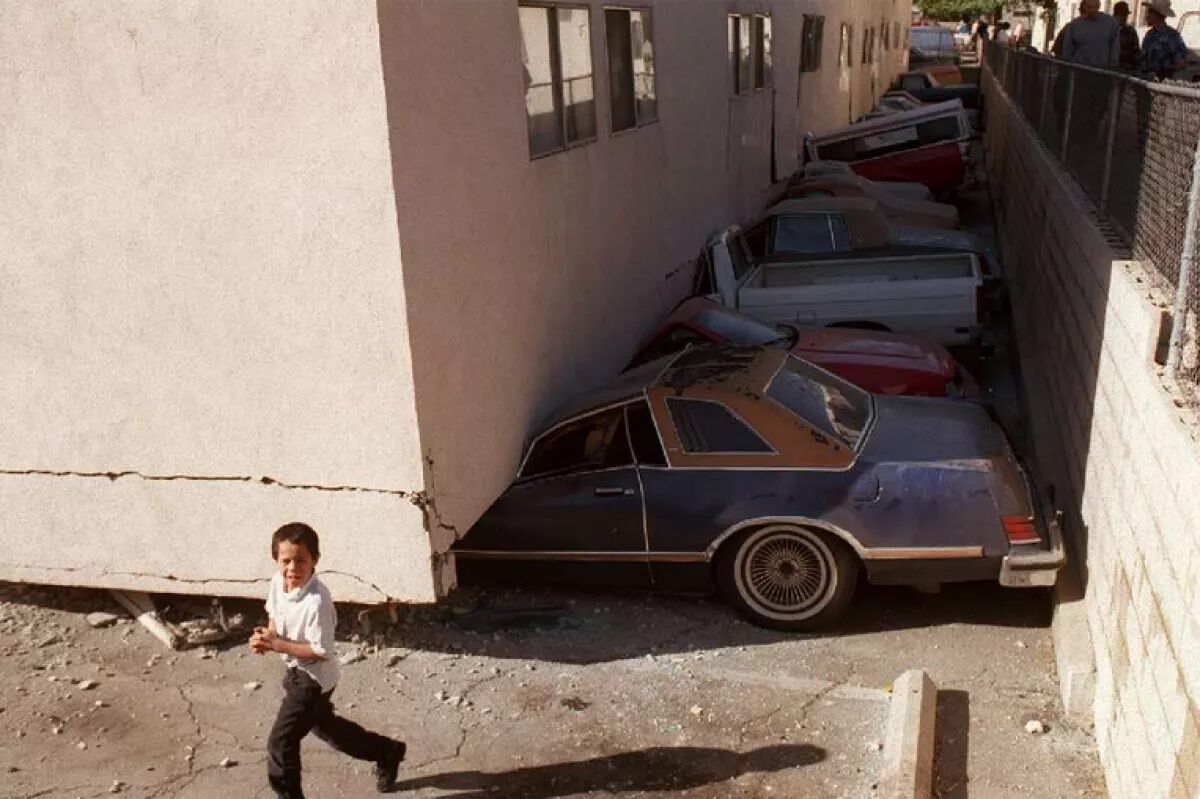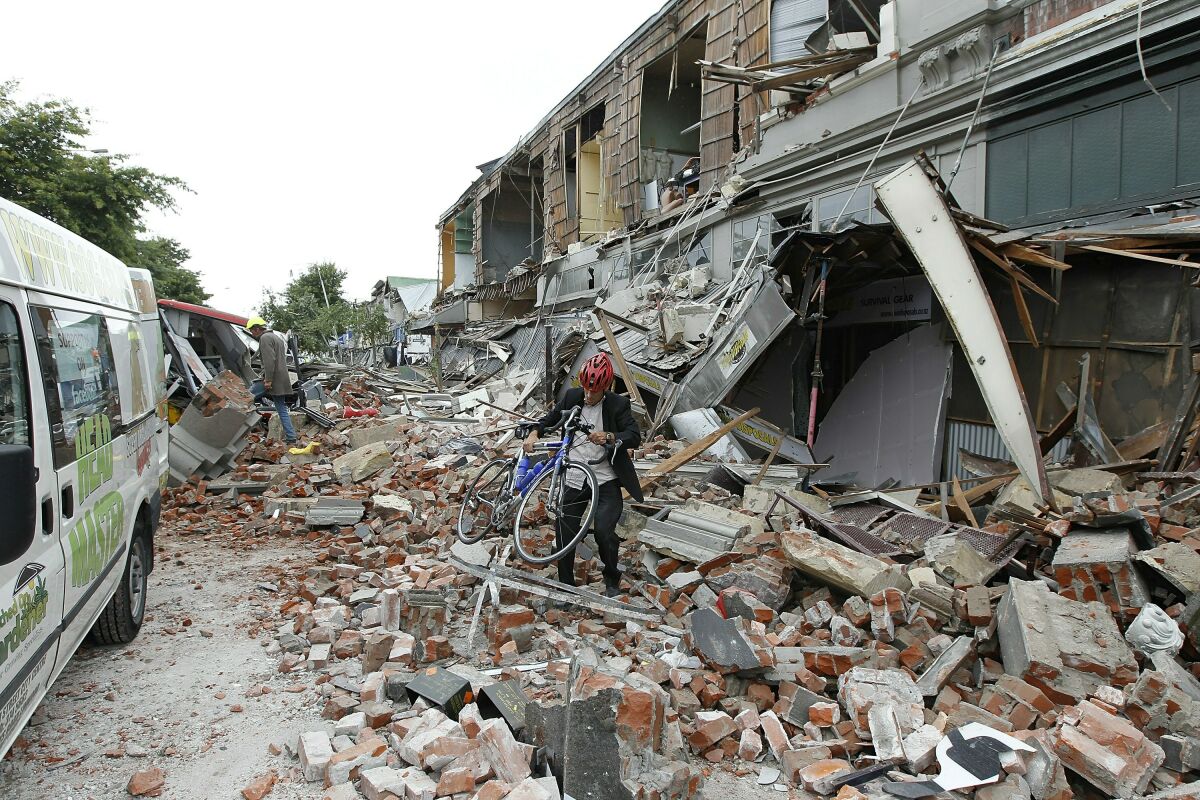Seven years into Los Angeles’ landmark earthquake safety campaign, more than 8,000 seismically vulnerable buildings have been retrofitted across the city at an estimated cost of $1.3 billion, a new analysis shows.
The improvements mark the biggest advance in seismic upgrades in decades but still leave thousands of buildings vulnerable to damage or even collapse in a catastrophic temblor.
The regulations, a legacy of Mayor Eric Garcetti’s push for the nation’s most sweeping earthquake safety legislation, require a total of nearly 14,000 buildings to be retrofitted. The rules came after years of stalled efforts to improve the resilience of buildings despite growing evidence of earthquake threats.
The rules target apartments and other structures with soft, flimsy first floors as well as larger concrete-frame buildings of the type that sustained major damage during the 1971 Sylmar and 1994 Northridge quakes.
Many of the completed retrofits have come in wood-frame, soft-story apartment buildings, where upgrades are considerably cheaper than those in brittle concrete-frame buildings. Under the city’s rules, property owners pay for the structural improvements, but landlords can pass on a portion of the costs to tenants.
Cyclists ride past the remains of a collapsed Kaiser Permanente clinic and office building in Granada Hills after the 1994 Northridge earthquake. The structure was a vulnerable concrete building.
(Jonathan Alcorn / Los Angeles Times)
Earthquake experts have been pushing communities across California to focus on strengthening key infrastructure to better withstand big quakes, including utilities, water systems and buildings. Though L.A. has targeted thousands of structures, it still has not dealt with another type of vulnerable construction: steel-frame buildings, of which 25 were significantly damaged in the Northridge earthquake. That includes the Automobile Club of Southern California building in Santa Clarita, which came very close to collapsing.
“Steel-frame buildings have the potential to fracture” a key part of their skeleton, said Ryan Kersting, who chairs the policy committee for the Structural Engineers Assn. of California. “And once you start to have that fracture, you are concerned with instability and possible collapse of those buildings.”
It would be important to conduct a case-by-case analysis to understand which buildings are at highest risk of collapse, even at lower shaking intensities, Kersting said. A U.S. Geological Survey simulation released in 2008 of a magnitude 7.8 earthquake in Southern California said it’s plausible that five high-rise steel buildings holding 5,000 people could collapse.
“We should be more informed about the risks that we have of our buildings,” Kersting said.
Nonetheless, L.A. and a handful of other cities have come a long way in the last few years. Cities such as Santa Monica, West Hollywood, Culver City, Beverly Hills and Pasadena now have laws requiring soft-story buildings to be retrofitted. In Northern California, San Francisco, Berkeley and Oakland have such laws on the books as well.
“That’s really big, and really huge, with really big benefits,” seismologist Lucy Jones said. “The most satisfying thing has been the really big shift about softer-story [buildings] and all that’s been able to be done about that.”
The report shows the benefits of L.A.’s law requiring soft-story buildings, also known as dingbats, to be retrofitted. A telltale sign of these structures are those with housing units above carports propped up by flimsy poles, which are vulnerable to collapse in an earthquake.

Kehl Tonga of Cal-Quake Construction installs a steel support to strengthen a quake-vulnerable soft-story apartment building in Hollywood.
(Mel Melcon / Los Angeles Times)
In the 1994 Northridge earthquake, about 200 soft-story buildings collapsed, including one apartment building in which 16 people died.
The report’s release comes 14 years after the first ShakeOut, a giant earthquake drill that asks residents to simulate what they would do in a temblor.
Of the 12,604 soft-story buildings identified by the Los Angeles Department of Building and Safety, 8,228 have been retrofitted, or 65%. Retrofit building permits also have been issued for an additional 2,068 buildings.

The skinny, flimsy columns supporting this El Centro apartment building left the structure unstable after a 2010 earthquake
(Fred Turner / California Seismic Safety Commission)
The study by structural engineer Keith Porter, an expert on California seismic safety issues, estimated that the retrofit of 8,100 soft-story apartment buildings in Los Angeles — that was the total when the analysis was conducted — strengthened 117,000 housing units. Officials estimate that the typical retrofit of a soft-story building in L.A. costs $80,000 to $160,000.
Porter estimated that property owners in L.A. have spent $1.3 billion so far on these retrofits.
But the benefits are already immense. Porter calculated that the retrofits will reduce future financial losses by $41 billion and avert 1,500 deaths and 27,000 nonfatal injuries and cases of post-traumatic stress disorder. The retrofits also are expected to prevent 5,000 housing units from collapsing and an additional 60,000 from being significantly damaged.
Calling it “a very cost-effective investment,” Porter calculated that every dollar invested in a retrofit will save $32 had the property owner not paid for seismic upgrades.
“These estimates omit important but hard-to-quantify benefits such as protecting mementos, pets, peace of mind, community and culture,” Porter wrote. “They ignore debris disposal, the energy embodied in repairing or replacing the buildings, and the increase in housing costs that accompany reduced housing supply.
“And this analysis is silent on the potential for displaced residents to become homeless, with attendant mental and physical health impacts, demands on public services and other harms,” he added.
“Retrofitting these buildings today will keep many tenants in their homes,” Porter said. “The retrofits will avoid thousands of injuries that would otherwise require emergency medical care, freeing up medical resources when they are in sudden, severe demand. The avoided losses benefit everyone.”
L.A.’s seismic retrofit law was passed after a Times analysis published in 2013 found that more than 1,000 old concrete buildings may be at risk of collapse in a major earthquake. The city had long known about the risk but had done little about it in the years after the 1994 Northridge earthquake.
Early in his term in January 2014, Garcetti announced a partnership with Jones to develop recommendations on addressing earthquake vulnerability issues. Jones, previously a scientist with the U.S. Geological Survey, was a key figure behind ShakeOut, the name for both the giant earthquake drill and the release of a report in 2008 showing the effect of a magnitude 7.8 earthquake on the southern San Andreas fault. In that scenario, scientists estimated a quake could cause 1,800 deaths, 50,000 injuries and $200 billion in damage and other losses.
By the end of 2014, Garcetti proposed a sweeping set of seismic safety rules that won the unanimous support of the City Council the following year.

Vehicles crushed when a soft-story apartment building collapsed during the Northridge earthquake in 1994.
(Roland Otero / Los Angeles Times)
But the work is not done. Improvements on the reliability of the electrical grid and fuel pipelines has been uneven, Jones said, and she remains concerned about the stability of Southern California‘s water supply.
L.A. has made slow progress on getting brittle concrete buildings retrofitted. City data show that only two of L.A.’s 1,337 brittle concrete buildings have received certificates of compliance showing they meet the standards of the retrofit law.
Owners of concrete buildings were given much longer to get them retrofitted — 25 years, compared with the seven years that owners of soft-story buildings had to upgrade.
Some owners of soft-story buildings began receiving orders to retrofit in 2016, meaning they still have some time before the seven-year deadline passes. Other owners began getting orders in 2017.
Concrete buildings can be especially deadly because they are so massive. The collapse of two concrete buildings in a quake in New Zealand in 2011 resulted in 133 deaths.
Jones remains particularly concerned about old brick buildings. A Times analysis in 2018 found that there were as many as 640 unreinforced masonry buildings in more than a dozen Inland Empire cities, including Riverside, Pomona and San Bernardino, that have been marked as dangerous but remained unretrofitted despite decades of warnings.
Little has been done to get those buildings retrofitted, despite the fact that the San Andreas fault runs through the region. By contrast, L.A. ordered that such structures be retrofitted or demolished decades ago.
In a statement, Garcetti said he hoped L.A. could be a model.
“While there’s still work to be done, we’ve positioned the city to continue expanding critical building requirements and serving as a model for cities around the world of what it looks like to be earthquake-ready,” he said.
In the 2011 New Zealand earthquake, more than 40 people died when brick and stone buildings collapsed. Most were not inside the buildings, but were killed by falling debris while on the sidewalk or in a vehicle on an adjacent road.
“It’s frustrating because we know those are ones that are going to kill people,” Jones said. “It requires thinking beyond the short term and believing in community and communal investments.”

Bricks from collapsed buildings fill a street in Christchurch, New Zealand, after an earthquake in 2011. More than 40 people died from the collapse of brick structures during the temblor.
(Martin Hunter / Getty Images)
Jones is also concerned about California’s minimum building standards, which still allow the construction of new buildings that can be so severely damaged in a major earthquake that they must be torn down. Quake safety advocates have promoted a new building standard that would have structures built stronger in the first place, so they can be repaired and reoccupied relatively quickly after a major temblor.
Then-Gov. Jerry Brown in 2018 vetoed a bill intended to strengthen the minimum construction requirements. The proposed law would have established a committee to evaluate whether a tougher building standard should be adopted and offer input on whether the new rule should be mandatory.
Porter has previously estimated that strengthening California’s minimum building standards would increase construction costs by 1% to 2%.
“Think of how many buildings have been built in downtown Los Angeles in the last 15 years. There’s a lot of them, and they are built to be a total financial loss” if built to the existing minimum construction standard, Jones said. “What’s going to happen to the economy of Southern California if we can’t use the buildings in downtown L.A.?”
















